

Compact Muon Solenoid
LHC, CERN
| CMS-PAS-HIG-16-005 | ||
| Search for lepton flavour violating decays of the Higgs boson in the $\mu$-$\tau$ final state at 13 TeV | ||
| CMS Collaboration | ||
| June 2016 | ||
| Abstract: A direct search for lepton flavour violating decays of the Higgs boson in the $\textrm{H} \rightarrow \mu \tau$ channel is described. In particular, the search examines the $\textrm{H} \rightarrow \mu \tau_{e}$ and the $\textrm{H} \rightarrow \mu \tau_{h}$ channels, where the $\tau$ leptons are reconstructed in the electronic and hadronic decay channels respectively. The data sample used in the search was collected in proton-proton collisions at $\sqrt{s}= $ 13 TeV with the CMS experiment at the LHC and corresponds to an integrated luminosity of 2.3 fb$^{-1}$. No excess is observed, and a 95% CL upper limit of $\mathcal{B}(\mathrm{H} \rightarrow \mu \tau ) <$ 1.20% (1.62 expected) is obtained. | ||
| Links: CDS record (PDF) ; inSPIRE record ; CADI line (restricted) ; | ||
| Figures | |

png pdf |
Figure 1-a:
Distributions of the collinear mass $M_\text {col}$ for signal and background processes after the loose selection requirements, for the LFV $\mathrm{ H } \to \mu\tau $ candidates, for the different channels and categories, compared to data. For visualization purposes $\mathcal {B}(\mathrm{ H } \to \mu\tau )=$ 100% is used for the signal. The shaded grey bands indicate the total uncertainty. The bottom panel in each plot shows the fractional difference between the observed data and the total estimated background. Top left: $\mathrm{ H } \to \mu\tau _{\mathrm{ e } }$ 0-jet; top right: $\mathrm{ H } \to \mu {\tau _\mathrm {h}} $ 0-jet; middle left: $\mathrm{ H } \to \mu\tau _{\mathrm{ e } }$ 1-jet; middle right: $\mathrm{ H } \to \mu {\tau _\mathrm {h}} $ 1-jet; bottom left: $\mathrm{ H } \to \mu\tau _{\mathrm{ e } }$ 2-jet; bottom right $\mathrm{ H } \to \mu {\tau _\mathrm {h}} $ 2-jet. |

png pdf |
Figure 1-b:
Distributions of the collinear mass $M_\text {col}$ for signal and background processes after the loose selection requirements, for the LFV $\mathrm{ H } \to \mu\tau $ candidates, for the different channels and categories, compared to data. For visualization purposes $\mathcal {B}(\mathrm{ H } \to \mu\tau )=$ 100% is used for the signal. The shaded grey bands indicate the total uncertainty. The bottom panel in each plot shows the fractional difference between the observed data and the total estimated background. Top left: $\mathrm{ H } \to \mu\tau _{\mathrm{ e } }$ 0-jet; top right: $\mathrm{ H } \to \mu {\tau _\mathrm {h}} $ 0-jet; middle left: $\mathrm{ H } \to \mu\tau _{\mathrm{ e } }$ 1-jet; middle right: $\mathrm{ H } \to \mu {\tau _\mathrm {h}} $ 1-jet; bottom left: $\mathrm{ H } \to \mu\tau _{\mathrm{ e } }$ 2-jet; bottom right $\mathrm{ H } \to \mu {\tau _\mathrm {h}} $ 2-jet. |
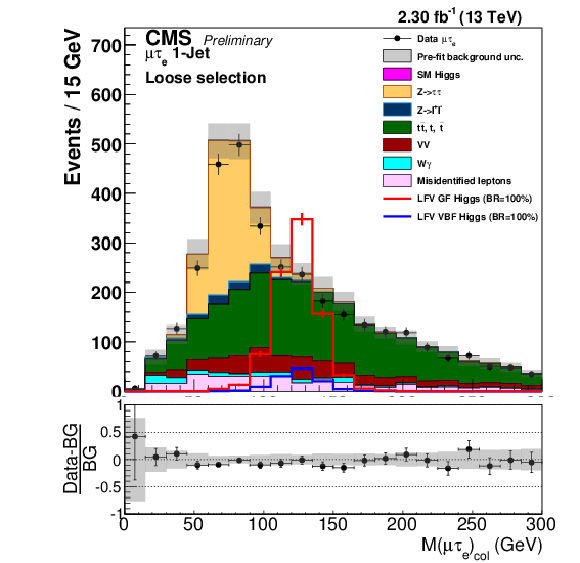
png pdf |
Figure 1-c:
Distributions of the collinear mass $M_\text {col}$ for signal and background processes after the loose selection requirements, for the LFV $\mathrm{ H } \to \mu\tau $ candidates, for the different channels and categories, compared to data. For visualization purposes $\mathcal {B}(\mathrm{ H } \to \mu\tau )=$ 100% is used for the signal. The shaded grey bands indicate the total uncertainty. The bottom panel in each plot shows the fractional difference between the observed data and the total estimated background. Top left: $\mathrm{ H } \to \mu\tau _{\mathrm{ e } }$ 0-jet; top right: $\mathrm{ H } \to \mu {\tau _\mathrm {h}} $ 0-jet; middle left: $\mathrm{ H } \to \mu\tau _{\mathrm{ e } }$ 1-jet; middle right: $\mathrm{ H } \to \mu {\tau _\mathrm {h}} $ 1-jet; bottom left: $\mathrm{ H } \to \mu\tau _{\mathrm{ e } }$ 2-jet; bottom right $\mathrm{ H } \to \mu {\tau _\mathrm {h}} $ 2-jet. |

png pdf |
Figure 1-d:
Distributions of the collinear mass $M_\text {col}$ for signal and background processes after the loose selection requirements, for the LFV $\mathrm{ H } \to \mu\tau $ candidates, for the different channels and categories, compared to data. For visualization purposes $\mathcal {B}(\mathrm{ H } \to \mu\tau )=$ 100% is used for the signal. The shaded grey bands indicate the total uncertainty. The bottom panel in each plot shows the fractional difference between the observed data and the total estimated background. Top left: $\mathrm{ H } \to \mu\tau _{\mathrm{ e } }$ 0-jet; top right: $\mathrm{ H } \to \mu {\tau _\mathrm {h}} $ 0-jet; middle left: $\mathrm{ H } \to \mu\tau _{\mathrm{ e } }$ 1-jet; middle right: $\mathrm{ H } \to \mu {\tau _\mathrm {h}} $ 1-jet; bottom left: $\mathrm{ H } \to \mu\tau _{\mathrm{ e } }$ 2-jet; bottom right $\mathrm{ H } \to \mu {\tau _\mathrm {h}} $ 2-jet. |
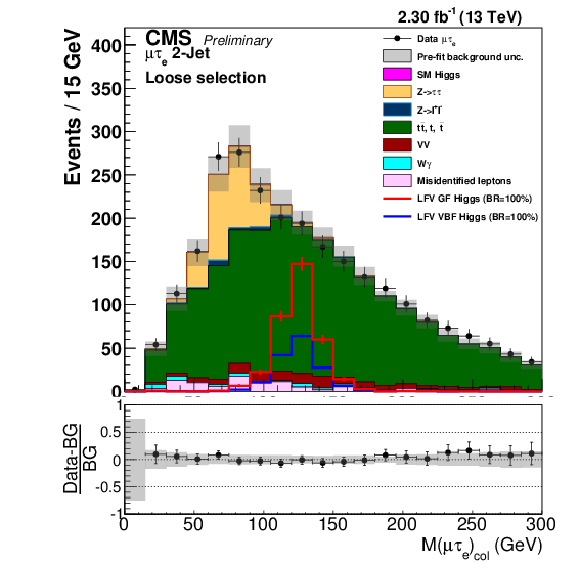
png pdf |
Figure 1-e:
Distributions of the collinear mass $M_\text {col}$ for signal and background processes after the loose selection requirements, for the LFV $\mathrm{ H } \to \mu\tau $ candidates, for the different channels and categories, compared to data. For visualization purposes $\mathcal {B}(\mathrm{ H } \to \mu\tau )=$ 100% is used for the signal. The shaded grey bands indicate the total uncertainty. The bottom panel in each plot shows the fractional difference between the observed data and the total estimated background. Top left: $\mathrm{ H } \to \mu\tau _{\mathrm{ e } }$ 0-jet; top right: $\mathrm{ H } \to \mu {\tau _\mathrm {h}} $ 0-jet; middle left: $\mathrm{ H } \to \mu\tau _{\mathrm{ e } }$ 1-jet; middle right: $\mathrm{ H } \to \mu {\tau _\mathrm {h}} $ 1-jet; bottom left: $\mathrm{ H } \to \mu\tau _{\mathrm{ e } }$ 2-jet; bottom right $\mathrm{ H } \to \mu {\tau _\mathrm {h}} $ 2-jet. |

png pdf |
Figure 1-f:
Distributions of the collinear mass $M_\text {col}$ for signal and background processes after the loose selection requirements, for the LFV $\mathrm{ H } \to \mu\tau $ candidates, for the different channels and categories, compared to data. For visualization purposes $\mathcal {B}(\mathrm{ H } \to \mu\tau )=$ 100% is used for the signal. The shaded grey bands indicate the total uncertainty. The bottom panel in each plot shows the fractional difference between the observed data and the total estimated background. Top left: $\mathrm{ H } \to \mu\tau _{\mathrm{ e } }$ 0-jet; top right: $\mathrm{ H } \to \mu {\tau _\mathrm {h}} $ 0-jet; middle left: $\mathrm{ H } \to \mu\tau _{\mathrm{ e } }$ 1-jet; middle right: $\mathrm{ H } \to \mu {\tau _\mathrm {h}} $ 1-jet; bottom left: $\mathrm{ H } \to \mu\tau _{\mathrm{ e } }$ 2-jet; bottom right $\mathrm{ H } \to \mu {\tau _\mathrm {h}} $ 2-jet. |

png pdf |
Figure 2-a:
Distributions of $M_\text {col}$ for region II compared to the estimate obtained by scaling the region IV sample by the measured misidentification fractions. The bottom panel in each plot shows the relative difference between the observed data and the estimate. a: $\mathrm{ H } \to \mu\tau _{\mathrm{ e } }$. b: $\mathrm{ H } \to \mu {\tau _\mathrm {h}} $. |
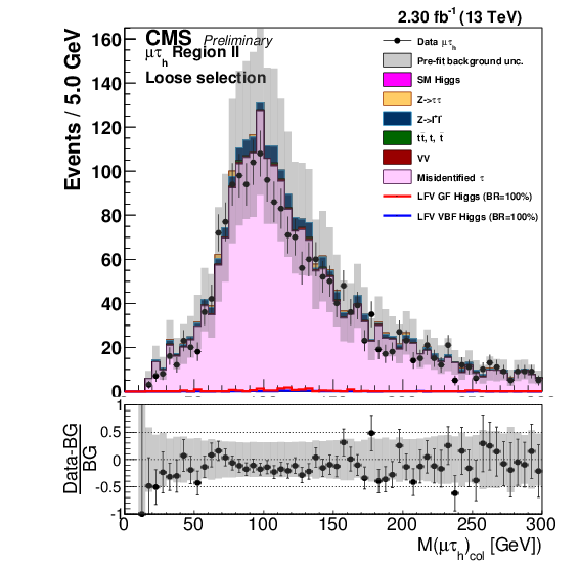
png pdf |
Figure 2-b:
Distributions of $M_\text {col}$ for region II compared to the estimate obtained by scaling the region IV sample by the measured misidentification fractions. The bottom panel in each plot shows the relative difference between the observed data and the estimate. a: $\mathrm{ H } \to \mu\tau _{\mathrm{ e } }$. b: $\mathrm{ H } \to \mu {\tau _\mathrm {h}} $. |
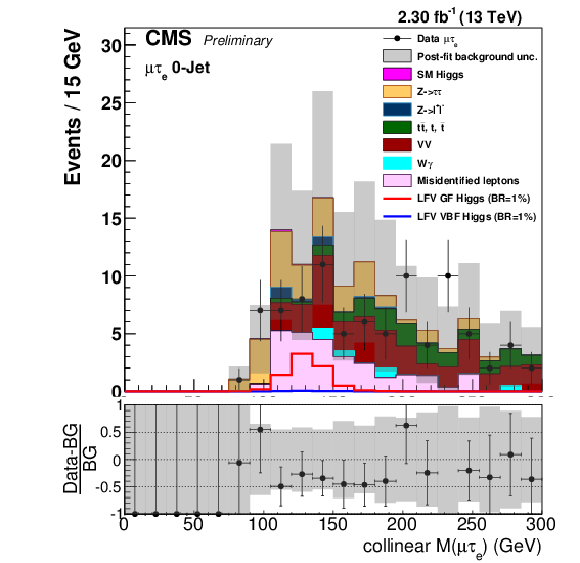
png pdf |
Figure 3-a:
Distribution of the collinear mass $M_\text {col}$ in the different channels and categories compared to the signal and background estimation. The background is normalized to the best-fit values from the signal plus background fit while the signal is normalized to $\mathcal {B}(\mathrm{ H } \to \mu\tau )=1%$. The bottom panel in each plot shows the fractional difference between the observed data and the fitted background. Top left: $\mathrm{ H } \to \mu\tau _{\mathrm{ e } }$ 0-jet; top right: $\mathrm{ H } \to \mu {\tau _\mathrm {h}} $ 0-jet; middle left: $\mathrm{ H } \to \mu\tau _{\mathrm{ e } }$ 1-jet; middle right: $\mathrm{ H } \to \mu {\tau _\mathrm {h}} $ 1-jet; bottom left: $\mathrm{ H } \to \mu\tau _{\mathrm{ e } }$ 2-jet; bottom right $\mathrm{ H } \to \mu {\tau _\mathrm {h}} $ 2-jet. |

png pdf |
Figure 3-b:
Distribution of the collinear mass $M_\text {col}$ in the different channels and categories compared to the signal and background estimation. The background is normalized to the best-fit values from the signal plus background fit while the signal is normalized to $\mathcal {B}(\mathrm{ H } \to \mu\tau )=1%$. The bottom panel in each plot shows the fractional difference between the observed data and the fitted background. Top left: $\mathrm{ H } \to \mu\tau _{\mathrm{ e } }$ 0-jet; top right: $\mathrm{ H } \to \mu {\tau _\mathrm {h}} $ 0-jet; middle left: $\mathrm{ H } \to \mu\tau _{\mathrm{ e } }$ 1-jet; middle right: $\mathrm{ H } \to \mu {\tau _\mathrm {h}} $ 1-jet; bottom left: $\mathrm{ H } \to \mu\tau _{\mathrm{ e } }$ 2-jet; bottom right $\mathrm{ H } \to \mu {\tau _\mathrm {h}} $ 2-jet. |

png pdf |
Figure 3-c:
Distribution of the collinear mass $M_\text {col}$ in the different channels and categories compared to the signal and background estimation. The background is normalized to the best-fit values from the signal plus background fit while the signal is normalized to $\mathcal {B}(\mathrm{ H } \to \mu\tau )=1%$. The bottom panel in each plot shows the fractional difference between the observed data and the fitted background. Top left: $\mathrm{ H } \to \mu\tau _{\mathrm{ e } }$ 0-jet; top right: $\mathrm{ H } \to \mu {\tau _\mathrm {h}} $ 0-jet; middle left: $\mathrm{ H } \to \mu\tau _{\mathrm{ e } }$ 1-jet; middle right: $\mathrm{ H } \to \mu {\tau _\mathrm {h}} $ 1-jet; bottom left: $\mathrm{ H } \to \mu\tau _{\mathrm{ e } }$ 2-jet; bottom right $\mathrm{ H } \to \mu {\tau _\mathrm {h}} $ 2-jet. |
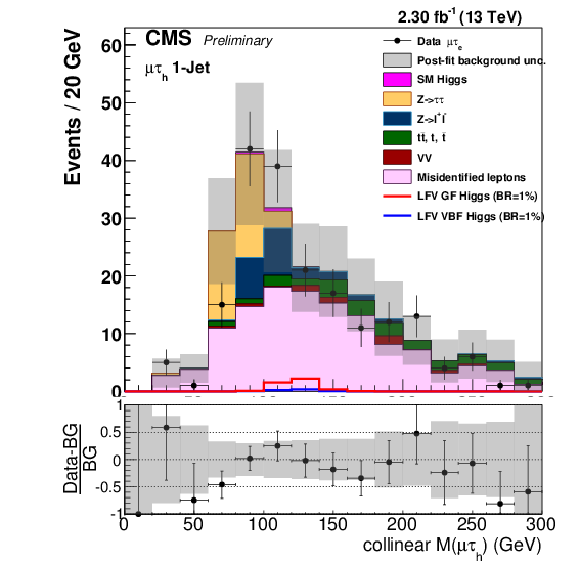
png pdf |
Figure 3-d:
Distribution of the collinear mass $M_\text {col}$ in the different channels and categories compared to the signal and background estimation. The background is normalized to the best-fit values from the signal plus background fit while the signal is normalized to $\mathcal {B}(\mathrm{ H } \to \mu\tau )=1%$. The bottom panel in each plot shows the fractional difference between the observed data and the fitted background. Top left: $\mathrm{ H } \to \mu\tau _{\mathrm{ e } }$ 0-jet; top right: $\mathrm{ H } \to \mu {\tau _\mathrm {h}} $ 0-jet; middle left: $\mathrm{ H } \to \mu\tau _{\mathrm{ e } }$ 1-jet; middle right: $\mathrm{ H } \to \mu {\tau _\mathrm {h}} $ 1-jet; bottom left: $\mathrm{ H } \to \mu\tau _{\mathrm{ e } }$ 2-jet; bottom right $\mathrm{ H } \to \mu {\tau _\mathrm {h}} $ 2-jet. |
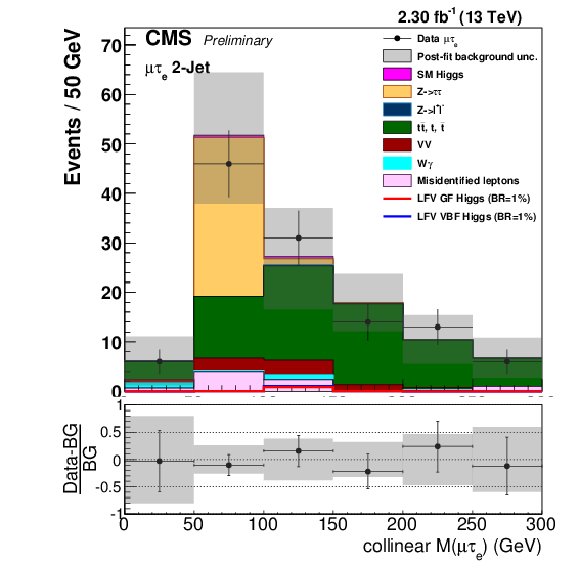
png pdf |
Figure 3-e:
Distribution of the collinear mass $M_\text {col}$ in the different channels and categories compared to the signal and background estimation. The background is normalized to the best-fit values from the signal plus background fit while the signal is normalized to $\mathcal {B}(\mathrm{ H } \to \mu\tau )=1%$. The bottom panel in each plot shows the fractional difference between the observed data and the fitted background. Top left: $\mathrm{ H } \to \mu\tau _{\mathrm{ e } }$ 0-jet; top right: $\mathrm{ H } \to \mu {\tau _\mathrm {h}} $ 0-jet; middle left: $\mathrm{ H } \to \mu\tau _{\mathrm{ e } }$ 1-jet; middle right: $\mathrm{ H } \to \mu {\tau _\mathrm {h}} $ 1-jet; bottom left: $\mathrm{ H } \to \mu\tau _{\mathrm{ e } }$ 2-jet; bottom right $\mathrm{ H } \to \mu {\tau _\mathrm {h}} $ 2-jet. |

png pdf |
Figure 3-f:
Distribution of the collinear mass $M_\text {col}$ in the different channels and categories compared to the signal and background estimation. The background is normalized to the best-fit values from the signal plus background fit while the signal is normalized to $\mathcal {B}(\mathrm{ H } \to \mu\tau )=1%$. The bottom panel in each plot shows the fractional difference between the observed data and the fitted background. Top left: $\mathrm{ H } \to \mu\tau _{\mathrm{ e } }$ 0-jet; top right: $\mathrm{ H } \to \mu {\tau _\mathrm {h}} $ 0-jet; middle left: $\mathrm{ H } \to \mu\tau _{\mathrm{ e } }$ 1-jet; middle right: $\mathrm{ H } \to \mu {\tau _\mathrm {h}} $ 1-jet; bottom left: $\mathrm{ H } \to \mu\tau _{\mathrm{ e } }$ 2-jet; bottom right $\mathrm{ H } \to \mu {\tau _\mathrm {h}} $ 2-jet. |

png pdf |
Figure 4:
Observed and expected 95% CL upper limits on the $\mathcal {B}(\mathrm{ H } \to \mu\tau )$ for each individual category and combined. The solid red and dashed black vertical lines correspond, respectively, to the observed and expected 95% CL upper limits obtained at $ \sqrt{s} = $ 8 TeV [23]. |
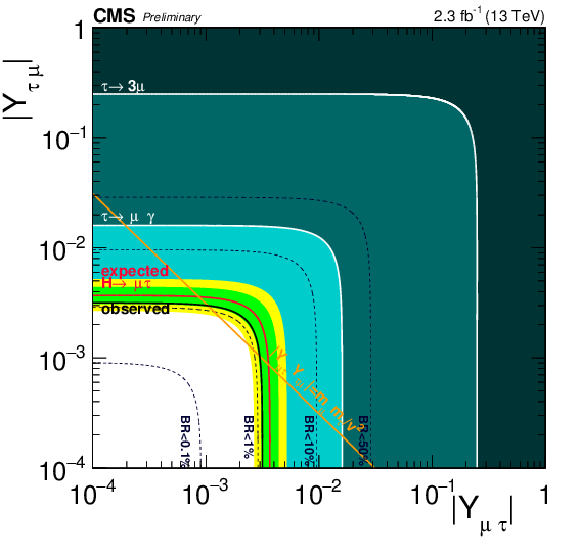
png pdf |
Figure 5:
Constraints on the flavour violating Yukawa couplings, $ {| Y_{\mu\tau } | }$ and $ {| Y_{\tau \mu } | }$. The black dashed lines are contours of $\mathcal {B}(\mathrm{ H } \to \mu\tau )$ for reference. The expected limit (red solid line) with one standard deviation (green) and two standard deviation (yellow) bands, and observed limit (black solid line) are derived from the limit on $\mathcal {B}(\mathrm{ H } \to \mu\tau )$ from the present analysis. The shaded regions are derived constraints from null searches for $\tau \to 3\mu $ (dark green) and $\tau \to \mu \gamma $ (lighter green). The light blue region indicates the additional parameter space excluded by our result. The purple diagonal line is the theoretical naturalness limit $Y_{ij}Y_{ji} \leq m_im_j/v^2$. |
| Tables | |
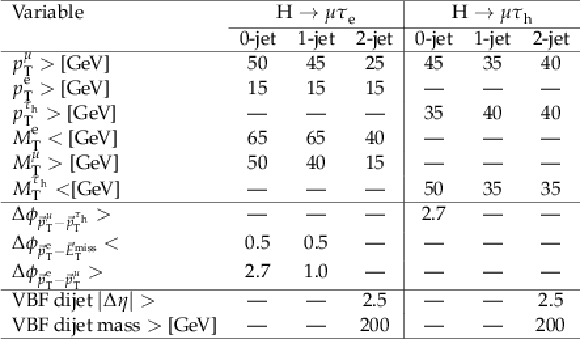
png pdf |
Table 1:
Selection criteria in all the categories used in the analysis |

png pdf |
Table 2:
Definition of the regions used to estimate the misidentified lepton background. The different regions have different requirements for the isolation and the relative charge of the two leptons $\ell ^{\pm }_{1}$ and $\ell ^{\pm }_{2}$, which can be $\mathrm{ e } $, $\mu $ or $\tau _{h}$. |

png pdf |
Table 3:
Systematic uncertainties in the expected event yield. All uncertainties are treated as correlated between the categories, except those which have two values indicated. In this case the first value is correlated as above, while the second value (following the $\oplus $ symbol) represents an uncorrelated uncertainty for each individual category. The total uncertainty in a given category is the sum in quadrature of the two values. |
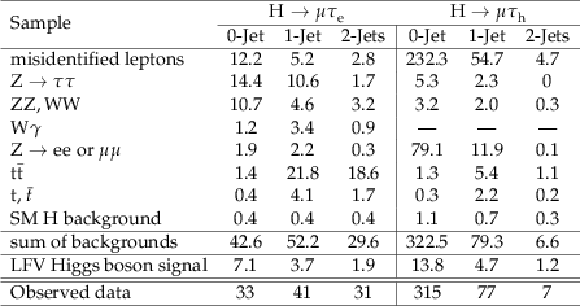
png pdf |
Table 4:
Event yields in the signal region in the range 100 $ < M_\text {col} < $ 150 GeV . The expected contributions are normalized to an integrated luminosity of 2.3 fb$^{-1}$. The LFV Higgs boson signal indicated corresponds to $B(\mathrm{ H } \to \mu \tau )=$ 1%, with the expected SM Higgs boson cross section. |

png pdf |
Table 5:
The observed and expected upper limits and the best-fit branching fractions for different $n$-jet categories for the $\mathrm{ H } \to \mu\tau $ process. |
| Summary |
|
A direct search for lepton flavour violating decays of the Higgs boson in the $\mathrm{H} \to \mu \tau$ channel is described. The data sample used in the search was collected in proton-proton collisions at $\sqrt{s} =$ 13 TeV with the CMS experiment at the LHC and corresponds to an integrated integrated luminosity of 2.3 fb$^{-1}$. No excess is observed. The best-fit branching fraction is $\mathcal{B}(\mathrm{H} \to \mu \tau ) = -0.76^{+0.81}_{-0.84}$% and an upper limit of $\mathcal{B}(\mathrm{H} \rightarrow \mu \tau ) <$ 1.20% (1.62 expected) is set at 95% CL. At $\sqrt{s} =$ 8 TeV a small excess was observed, corresponding to 2.4$\sigma$, with an analysis based on an integrated luminosity of 19.7 fb$^{-1}$ that yielded an expected 95% CL limit on the branching fraction of 0.75%. More data are needed to make definitive conclusions on the origin of that excess. |
| References | ||||
| 1 | ATLAS Collaboration | Observation of a new particle in the search for the Standard Model Higgs boson with the ATLAS detector at the LHC | PLB 716 (2012) 1 | 1207.7214 |
| 2 | CMS Collaboration | Observation of a new boson at a mass of 125 GeV with the CMS experiment at the LHC | PLB 716 (2012) 30 | CMS-HIG-12-028 1207.7235 |
| 3 | CMS Collaboration | Observation of a new boson with mass near 125 GeV in pp collisions at $ \sqrt{s} $ = 7 and 8 TeV | JHEP 06 (2013) 081 | CMS-HIG-12-036 1303.4571 |
| 4 | R. Harnik, J. Kopp, and J. Zupan | Flavor violating Higgs decays | JHEP 03 (2013) 26 | |
| 5 | J. D. Bjorken and S. Weinberg | Mechanism for Nonconservation of Muon Number | PRL 38 (1977) 622 | |
| 6 | J. L. Diaz-Cruz and J. Toscano | Lepton flavor violating decays of Higgs bosons beyond the standard model | PRD 62 (2000) 116005 | hep-ph/9910233 |
| 7 | T. Han and D. Marfatia | $ h \to \mu \tau $ at Hadron Colliders | PRL 86 (2001) 1442 | hep-ph/0008141 |
| 8 | A. Arhrib, Y. Cheng, and O. C. Kong | Comprehensive analysis on lepton flavor violating Higgs boson to $ \mu\bar{\tau} + \tau \bar{\mu} $ decay in supersymmetry without R parity | PRD 87 (2013) 015025 | 1210.8241 |
| 9 | K. Agashe and R. Contino | Composite Higgs-mediated flavor-changing neutral current | PRD 80 (2009) 075016 | 0906.1542 |
| 10 | A. Azatov, M. Toharia, and L. Zhu | Higgs mediated flavor changing neutral currents in warped extra dimensions | PRD 80 (2009) 035016 | 0906.1990 |
| 11 | H. Ishimori et al. | Non-Abelian Discrete Symmetries in Particle Physics | Prog. Theor. Phys. Suppl. 183 (2010) 1 | 1003.3552 |
| 12 | G. Perez and L. Randall | Natural neutrino masses and mixings from warped geometry | JHEP 01 (2009) 077 | 0805.4652 |
| 13 | S. Casagrande et al. | Flavor physics in the Randall-Sundrum model I. Theoretical setup and electroweak precision tests | JHEP 10 (2008) 094 | 0807.4937 |
| 14 | A. J. Buras, B. Duling, and S. Gori | The impact of Kaluza-Klein fermions on Standard Model fermion couplings in a RS model with custodial protection | JHEP 09 (2009) 076 | 0905.2318 |
| 15 | M. Blanke et al. | $ \Delta F=2 $ observables and fine-tuning in a warped extra dimension with custodial protection | JHEP 03 (2009) 001 | 0809.1073 |
| 16 | G. F. Giudice and O. Lebedev | Higgs-dependent Yukawa couplings | PLB 665 (2008) 79 | 0804.1753 |
| 17 | J. Aguilar-Saavedra | A minimal set of top-Higgs anomalous couplings | Nucl. Phys. B 821 (2009) 215 | 0904.2387 |
| 18 | M. E. Albrecht et al. | Electroweak and flavour structure of a warped extra dimension with custodial protection | JHEP 09 (2009) 064 | 0903.2415 |
| 19 | A. Goudelis, O. Lebedev, and J. H. Park | Higgs-induced lepton flavor violation | PLB 707 (2012) 369 | 1111.1715 |
| 20 | D. McKeen, M. Pospelov, and A. Ritz | Modified Higgs branching ratios versus CP and lepton flavor violation | PRD 86 (2012) 113004 | 1208.4597 |
| 21 | A. Pilaftsis | Lepton flavour nonconservation in $ \mathrm{ H }^0 $ decays | PLB 285 (1992) 68 | |
| 22 | J. G. K\"orner, A. Pilaftsis, and K. Schilcher | Leptonic $ \mathrm{CP} $ asymmetries in flavor-changing $ \mathrm{ H }^{0} $ decays | PRD 47 (1993) 1080 | |
| 23 | CMS Collaboration | Search for lepton-flavour-violating decays of the Higgs boson | PLB 749 (2015) 337 | CMS-HIG-14-005 1502.07400 |
| 24 | CMS Collaboration | Search for lepton-flavour-violating decays of the Higgs boson to e$ \tau $ and e$ \mu $ at $ \sqrt{s}=8 $ TeV | CMS-PAS-HIG-14-040 | CMS-PAS-HIG-14-040 |
| 25 | ATLAS Collaboration | Search for lepton-flavour-violating $ \mathrm{ H }\to\mu\tau $ decays of the Higgs boson with the ATLAS detector | Submitted to JHEP.\ | 1508.03372 |
| 26 | ATLAS Collaboration | Search for lepton-flavour-violating decays of the Higgs and $ Z $ bosons with the ATLAS detector | 1604.07730 | |
| 27 | B. McWilliams and L.-F. Li | Virtual effects of Higgs particles | Nucl. Phys. B 179 (1981) 62 | |
| 28 | O. U. Shanker | Flavour violation, scalar particles and leptoquarks | Nucl. Phys. B 206 (1982) 253 | |
| 29 | G. Blankenburg, J. Ellis, and G. Isidori | Flavour-changing decays of a 125 GeV Higgs-like particle | PLB 712 (2012) 386 | 1202.5704 |
| 30 | K. Olive et al. | Review of Particle Physics | CPC 38 (2014) 090001 | |
| 31 | CMS Collaboration | Evidence for the direct decay of the 125 GeV Higgs boson to fermions | Nature Phys. 10 (2014) 557 | CMS-HIG-13-033 1401.6527 |
| 32 | CMS Collaboration | Evidence for the 125$ GeV $ Higgs boson decaying to a pair of $ \tau $ leptons | JHEP 05 (2014) 104 | CMS-HIG-13-004 1401.5041 |
| 33 | ATLAS Collaboration | Evidence for the Higgs-boson Yukawa coupling to tau leptons with the ATLAS detector | JHEP 04 (2015) 117 | 1501.04943 |
| 34 | CMS Collaboration | The CMS experiment at the CERN LHC | JINST 3 (2008) S08004 | CMS-00-001 |
| 35 | GEANT4 Collaboration | GEANT4 --- a simulation toolkit | NIMA 506 (2003) 250 | |
| 36 | P. Nason | A new method for combining NLO QCD with shower Monte Carlo algorithms | JHEP 11 (2004) 040 | hep-ph/0409146 |
| 37 | S. Frixione, P. Nason, and C. Oleari | Matching NLO QCD computations with parton shower simulations: the POWHEG method | JHEP 11 (2007) 070 | 0709.2092 |
| 38 | S. Alioli, P. Nason, C. Oleari, and E. Re | A general framework for implementing NLO calculations in shower Monte Carlo programs: the POWHEG BOX | JHEP 06 (2010) 043 | 1002.2581 |
| 39 | S. Alioli et al. | Jet pair production in POWHEG | JHEP 04 (2011) 081 | 1012.3380 |
| 40 | S. Alioli, P. Nason, C. Oleari, and E. Re | NLO Higgs boson production via gluon fusion matched with shower in POWHEG | JHEP 04 (2009) 002 | 0812.0578 |
| 41 | T. Sj\"ostrand, S. Mrenna, and P. Skands | A Brief Introduction to PYTHIA 8.1 | CPC 178 (2007) 852 | 0710.3820 |
| 42 | J. Alwall et al. | MadGraph 5: going beyond | JHEP 06 (2011) 128 | 1106.0522 |
| 43 | CMS Collaboration | Event generator tunes obtained from underlying event and multiparton scattering measurements | CMS-GEN-14-001 1512.00815 |
|
| 44 | CMS Collaboration | Description and performance of track and primary-vertex reconstruction with the CMS tracker | JINST 9 (2014) P10009 | CMS-TRK-11-001 1405.6569 |
| 45 | CMS Collaboration | Particle--Flow Event Reconstruction in CMS and Performance for Jets, Taus, and $ E_{\mathrm{T}}^{\text{miss}} $ | CDS | |
| 46 | CMS Collaboration | Particle flow reconstruction of 0.9 TeV and 2.36 TeV collision events in CMS | CDS | |
| 47 | CMS Collaboration | Commissioning of the particle--flow event reconstruction with leptons from J/$ \psi $ and $ \mathrm{ W } $ decays at 7 TeV | CDS | |
| 48 | CMS Collaboration | Performance of the CMS missing transverse momentum reconstruction in pp data at $ \sqrt{s} $ = 8 TeV | JINST 10 (2015) P02006 | CMS-JME-13-003 1411.0511 |
| 49 | CMS Collaboration | Performance of electron reconstruction and selection with the CMS detector in proton-proton collisions at $ \sqrt{s} $ = 8 TeV | JINST 10 (2015) P06005 | CMS-EGM-13-001 1502.02701 |
| 50 | CMS Collaboration | Performance of CMS muon reconstruction in pp collision events at $ \sqrt{s} = 7 $$ TeV $ | Submitted to J. Inst | CMS-MUO-10-004 1206.4071 |
| 51 | CMS Collaboration | Reconstruction and identification of τ lepton decays to hadrons and ν$ _τ $ at CMS | JINST 11 (2016) P01019 | CMS-TAU-14-001 1510.07488 |
| 52 | M. Cacciari, G. P. Salam, and G. Soyez | FastJet user manual | EPJC 72 (2012) 1896 | 1111.6097 |
| 53 | M. Cacciari, G. P. Salam, and G. Soyez | The anti-$ k_t $ jet clustering algorithm | JHEP 04 (2008) 063 | 0802.1189 |
| 54 | CMS Collaboration | Determination of jet energy calibration and transverse momentum resolution in CMS | JINST 6 (2011) 11002 | CMS-JME-10-011 1107.4277 |
| 55 | CMS Collaboration | Performance of CMS muon reconstruction in pp collision events at $ \sqrt{7} $~$ TeV $ | JINST 7 (2012) P10002 | CMS-MUO-10-004 1206.4071 |
| 56 | R. K. Ellis, I. Hinchliffe, M. Soldate, and J. van der Bij | Higgs Decay to $ \tau^+\tau^- $: A possible signature of intermediate mass Higgs bosons at high energy hadron colliders | Nucl. Phys. B 297 (1988) 221 | |
| 57 | CMS Collaboration | Identification of b-quark jets with the CMS experiment | JINST 8 (2013) P04013 | CMS-BTV-12-001 1211.4462 |
| 58 | ATLAS and CMS Collaborations, LHC Higgs Combination Group | Procedure for the LHC Higgs boson search combination in Summer 2011 | Technical Report ATL-PHYS-PUB 2011-11, CMS NOTE 2011/005 | |
| 59 | T. Junk | Confidence level computation for combining searches with small statistics | NIMA 434 (1999) 435 | hep-ex/9902006 |
| 60 | A. L. Read | Presentation of search results: the $ CL_s $ technique | JPG 28 (2002) 2693 | |
| 61 | A. Denner et al. | Standard model Higgs-boson branching ratios with uncertainties | EPJC 71 (2011) 1753 | 1107.5909 |

|
Compact Muon Solenoid LHC, CERN |

|

|

|

|

|

|